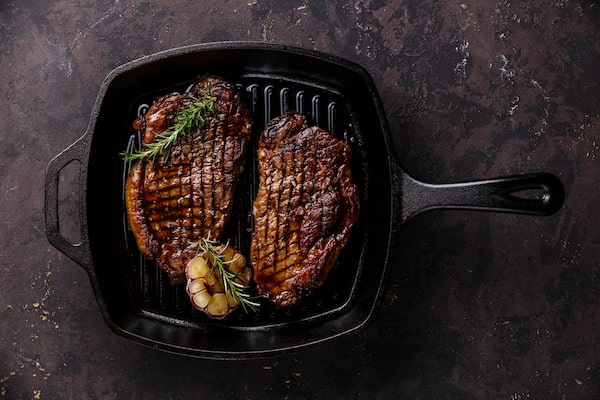
Iron-rich animal foods, which contain highly absorbable 'heme' iron, include lean beef, clams, oysters, mussels and sardines.Lisovskaya Natalia/iStockPhoto / Getty Images
Iron deficiency anemia is the most common nutrient deficiency in the world, with women and young children being affected the most.
Because iron is needed for many different functions in the body, deficiency symptoms can vary among individuals. The most common sign, though, is fatigue – even a mild dip in iron stores can make you feel sluggish and weak.
Here’s what to know about iron deficiency anemia – how to identify and treat it, plus diet strategies to maintain healthy iron stores.
Why you need iron
Your body uses iron to make hemoglobin, a protein in red blood cells that transports oxygen from your lungs to your organs and other bodily tissues. Without adequate iron, your body can’t produce enough oxygen-carrying hemoglobin, which can leave you feeling tired and short of breath.
Iron is also needed to maintain skin, hair and nails, make hormones and connective tissue and support proper muscle and nerve function. And the mineral plays a role in brain function and a healthy immune system.
Signs of iron deficiency anemia
Tiredness, fatigue on exertion and light-headedness are common signs of iron deficiency anemia. Pale skin, headaches, hair loss, brittle nails and cold feet and hands may also occur.
Difficulty concentrating, irritability and increased susceptibility to infections are other signs of depleted iron stores. If left untreated, iron deficiency can also lead to low mood.
Six healthy recipe ideas – and tips for better meal planning
Iron deficiency isn’t always easy to identify. Some symptoms are ones you might chalk up to a hectic lifestyle, stress or lack of sleep. Keep in mind, too, that signs of low iron can be caused by other health conditions.
For these reasons, if you feel you might have low iron consult your doctor for a proper diagnosis.
Who’s at risk?
Pregnancy increases iron demands, creating a greater risk of iron deficiency anemia (this is also the case for rapidly growing infants and young children). Menstruation also increases the risk of iron deficiency.
Vegetarians, vegans and other people whose diets don’t include many iron-rich foods can, over time, develop iron deficiency.
Gastrointestinal disorders that interfere with the body’s ability to absorb iron, such as celiac disease and inflammatory bowel disease, can lead to iron deficiency. Medications that reduce stomach acid can also suppress iron absorption.
Diagnosing iron deficiency
Iron deficiency progresses through stages. Mild iron deficiency occurs when iron stores in the body, measured by a ferritin blood test, become depleted. Ferritin is a protein inside cells that stores iron.
A low ferritin indicates low iron stores and iron deficiency; you may or may not have anemia.
Iron deficiency anemia occurs when iron stores have been exhausted and hemoglobin declines. It is diagnosed by a complete blood count (CBC), a test that measures the amount of hemoglobin. A low hemoglobin indicates iron deficiency anemia.
Treating iron deficiency
Iron supplements containing 100 to 150 mg of elemental iron are required to treat iron deficiency anemia; typically diet alone or multivitamins cannot replenish iron stores. Elemental iron is the amount of iron in the supplement that’s available for absorption; it’s listed on the label.
Supplements containing “ferrous” forms of iron are often used to treat a deficiency. Higher doses of ferrous iron may cause stomach upset and constipation; other forms, such as polysaccharide-iron complexes, have fewer gastrointestinal side effects.
What is the anti-inflammatory diet plan?
For mild iron deficiency, a lower dose iron supplement (20 to 30 mg) may be adequate to rebuild iron stores.
Iron is best absorbed when taken on an empty stomach, two hours before or four hours after a meal. Taking iron with vitamin C – a glass of orange juice or a 250 mg vitamin C supplement – can also improve absorption. If you take a calcium supplement, take iron at a different time of day.
Once your doctor has determined your iron stores are replenished, which can take several months, high dose iron supplements should be discontinued.
How to maintain your iron stores
Include foods high in iron in your daily diet. Iron-rich animal foods, which contain highly absorbable “heme” iron, include lean beef, clams, oysters, mussels and sardines.
Plant foods contain “non-heme,” which is less well absorbed. Foods high in this type of iron include white beans, lentils, kidney beans, chickpeas, lima beans, cooked spinach, edamame, firm tofu, raisins, prune juice, cashews, pumpkin seeds, quinoa and fortified breakfast cereals.
To enhance non-heme iron absorption, eat a vitamin C-rich food at each meal (e.g., strawberries, citrus fruit, kiwi fruit, bell peppers, cauliflower, tomato sauce).
A daily multivitamin and mineral supplement that includes iron can also help keep iron stores up.
Leslie Beck, a Toronto-based private practice dietitian, is director of food and nutrition at Medcan. Follow her on Twitter @LeslieBeckRD